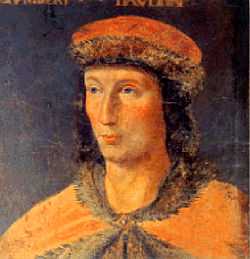Humbert II of Viennois
| Humbert II, Dauphin of Viennois | |
|---|---|
| Dauphin of the Viennois | |
|
Humbert II | |
| Spouse(s) | Marie of Baux |
|
Issue
André | |
| Noble family | La Tour-du-Pin |
| Father | John II, Dauphin of Vienne |
| Mother | Beatrice of Hungary |
| Born | 1312 |
| Died | 4 May 1355[1] |


Humbert II de la Tour-du-Pin (1312 – 4 May 1355) was the Dauphin of the Viennois from 1333 to 16 July 1349. He was a son of the Dauphin John II and Beatrice of Hungary. Humbert was the last dauphin before the title went to the French crown, to be bestowed on the heir apparent.
Career
When Humbert inherited the Dauphiné on the death of his brother Guigues VIII in 1333, they were at war with Aymon, Count of Savoy. Within a year, Philip VI of France was able to broker a truce between the new Dauphin and Savoy.[2]
To contemporaries, he was incompetent and extravagant, lacking the warlike ardour of his brother Guigues. He passed his youth at Naples enjoying the aesthetic pleasures of the Italian trecento.[3] His subsequent court at Beauvoir-en-Royans had a reputation for extravagance. Unlike his predecessors, Humbert was not itinerant, moving continually from one dauphinal castle to another, instead preferring to settle in Beauvoir.
He married Marie of Baux, niece of Robert, King of Naples by his sister Beatrice.[4]
In 1333, Louis IV, Holy Roman Emperor, sought to counter French influence in the region, and offered Humbert the Kingdom of Arles, an opportunity to gain full authority over Savoy, Provence, and surrounding territories. Humbert was reluctant to take the crown and the conflict that would follow with all around him, so he declined. Subsequently, Humbert found himself more and more financially dependent on Philip VI of France.[5]
He depleted his treasury funding a vain Crusade to rescue the Holy Land, but after the death of his only son André (5 September 1333 – Grenoble, October 1335), he quickly gave up the idea and by 1337 was planning to cede his inheritance. He first offered it to Robert of Naples, who did not like the terms.[6] In 1339, financial difficulties building up, he made an inventory of his possessions, with the hope of selling them to Pope Benedict XII.
In May 1345, Humbert had left Marseille at the head of a papal fleet. The Crusade was against the Turkish Emirate of Aydin, and was intended to assist the recently captured Frankish port of Smyrna, but was attacked by Genoa near Rhodes. He was asked to intervene by Venice in the conflict between Bartolomeo Zaccaria and Guglielma Pallavicini over the marquisate of Bodonitsa. He returned before the Crusade had achieved anything notable.
His wife died around the start of 1347, shortly before he returned from the crusade.[7] As he was returning, he joined John II, Marquess of Montferrat and Thomas II, Marquess of Saluzzo in their fight against Joanna I of Naples who was supported by the Savoyards. When Pope Clement VI brought the two sides to negotiations, the terms included the possibility of Humbert marrying Bianca of Savoy, though this did not reach agreement.[8]
The planned sale to the pope falling through, Humbert finally succeeded in completing a sale to Philip VI of France in 1349 for 400,000 écus and an annual pension. To save appearances, however, the sale was referred to as a "transfer". In order to prevent the title from going into abeyance or being swallowed up in another sovereign title, Humbert instituted the "Delphinal Statute" whereby the Dauphiné was exempted from many taxes and imposts. This statute was subject to much parliamentary debate at regional level, as local leaders sought to defend their autonomy and privilege against the state.
After ceding his lands, Humbert entered the Dominican Order gaining the ecclesiastical title of Patriarch of Alexandria within two years, and consecrating Rodolphe de Chissé as Bishop of Grenoble in 1351.[9] It is with these latter titles that his death is recorded in a necrology of Vauvert: in Clermont-en-Auvergne, at forty three years of age in 1355. He was buried in the now demolished church of Couvent des Jacobins in Paris.
Notes
References
- Cheney, C. R. (Apr 1935). "The Diocese of Grenoble in the Fourteenth Century". Speculum 10 (2).
- Cox, Eugene L. (1967). The Green Count of Savoy. Princeton, New Jersey: Princeton University Press. LCCN 67-11030.
- Setton, The Papacy and the Levant (1204-1571), vol. 1 (Philadelphia, 1976), Chapter 10,‘Clement VI, Humbert and end of the crusade to Smyrna, 1345-52’, pp. 195–223.
- Miller, W. "The Marquisate of Boudonitza (1204-1414)." Journal of Hellenic Studies, Vol. 28, 1908, pp 234–249.
- Cawley, Charles, Medieval Lands Project: Nobility of the Kingdom of Burgundy., Foundation for Medieval Genealogy, retrieved August 2012,
